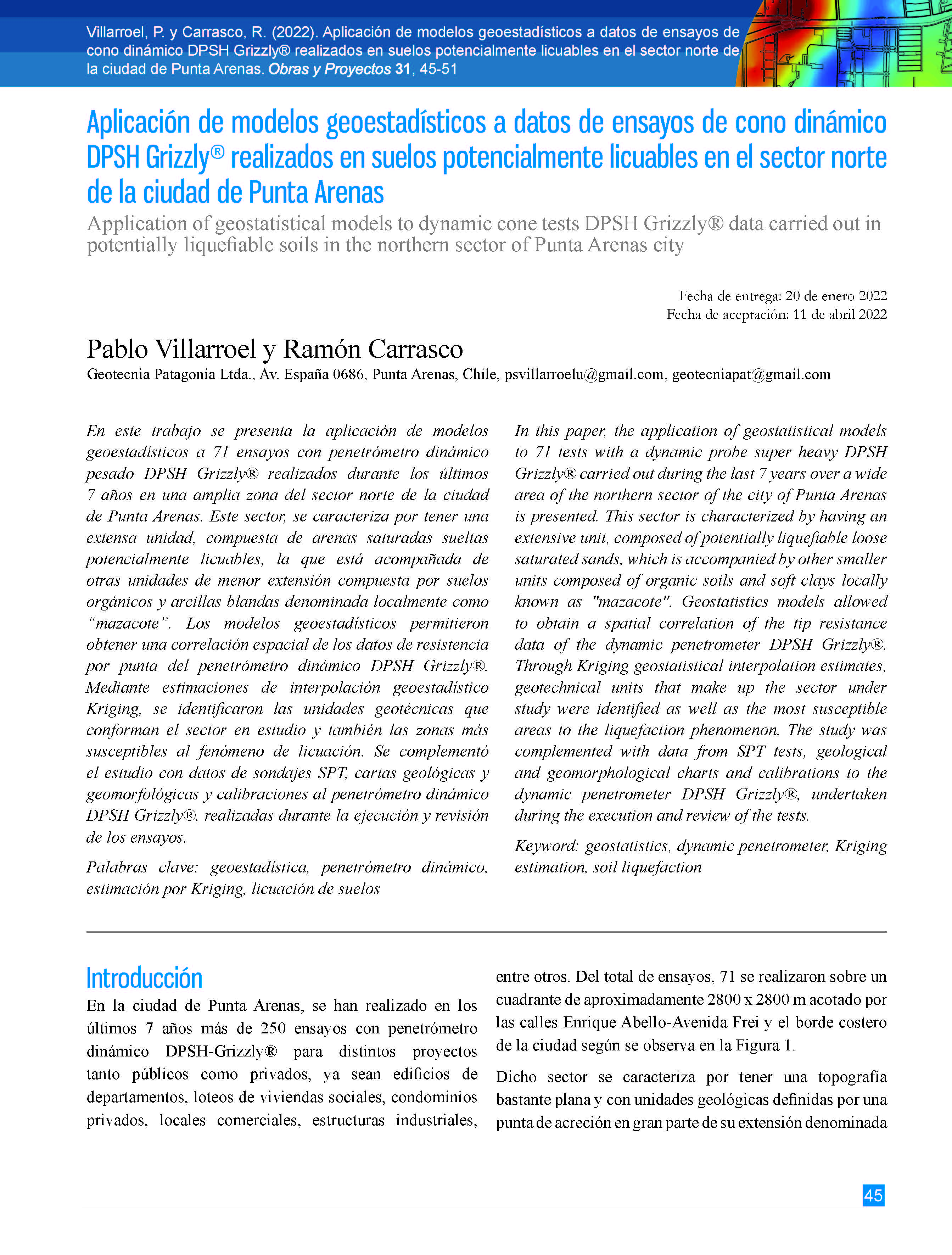Aplicación de modelos geoestadísticos a datos de ensayos de cono dinámico DPSH Grizzly® realizados en suelos potencialmente licuables en el sector norte de la ciudad de Punta Arenas
DOI:
https://doi.org/10.4067/s0718-28132022000100045Palabras clave:
Geoestadística, Penetrómetro dinámico, Estimación por Kriging, Licuación de suelosResumen
En este trabajo se presenta la aplicación de modelos geoestadísticos a 71 ensayos con penetrómetro dinámico pesado DPSH Grizzly® realizados durante los últimos 7 años en una amplia zona del sector norte de la ciudad de Punta Arenas. Este sector, se caracteriza por tener una extensa unidad, compuesta de arenas saturadas sueltas potencialmente licuables, la que está acompañada de otras unidades de menor extensión compuesta por suelos orgánicos y arcillas blandas denominada localmente como “mazacote”. Los modelos geoestadísticos permitieron obtener una correlación espacial de los datos de resistencia por punta del penetrómetro dinámico DPSH Grizzly®. Mediante estimaciones de interpolación geoestadístico Kriging, se identificaron las unidades geotécnicas que conforman el sector en estudio y también las zonas más susceptibles al fenómeno de licuación. Se complementó el estudio con datos de sondajes SPT, cartas geológicas y geomorfológicas y calibraciones al penetrómetro dinámico DPSH Grizzly®, realizadas durante la ejecución y revisión de los ensayos.
Referencias
Benz-Navarrete, M.A., Breul, P. and Moustan, P. (2019). Servoassisted and computer-controlled variable energy dynamic super heavy penetrometer. XVI Pan-American Conference on Soil Mechanics and Geotechnical Engineering, López-Acosta et al. (eds.), Cancun, Mexico, IOS Press, 65-72.
Carrasco, R. (1997). Zonificación geotécnica en algunos sectores de Punta Arenas y soluciones particulares para mejoramiento y fundaciones. Memoria de título de Ingeniero Civil, Universidad Técnica Federico Santa María, Valparaíso, Chile.
EN ISO 22476-2 (2005). Geotechnical investigation and testing – Field testing – Part 2: Dynamic probing. European Committee for Standardization, Brussels, Belgium.
Iwasaki, T., Arakawa, T. and Tokida, K. (1982). Simplified procedures for assessing soil liquefaction during earthquakes. Conference on Soil Dynamics and Earthquake Engineering. Southampton, UK, 925–939.
Iwasaki, T., Tokida, K. and Tatsuoka, F. (1981). Soil liquefaction potential evaluation with use of the simplified procedure. First International Conference on Recent Advances in Geotechnical Earthquake Engineering and Soil Dynamics, St. Louis MO, USA, 209-214.
Iwasaki, T., Tatsuoka, F., Tokida, K. and Yasuda S. (1978). A practical method for assessing soil liquefaction potential based on case studies at various sites in Japan. 2nd International Conference on Microzonation for Safer Construction – Research and Application, San Francisco CA, USA, vol. 2, 885–896.
Peredo, V. y Carrasco, R. (2018). Correlación entre el ensayo penetrómetro dinámico Grizzly (DPSH) y SPT en arenas potencialmente licuables del sector Punta Arenosa en la ciudad de Punta Arenas. X Congreso Chileno de Geotecnia. Valparaíso, Chile, artículo 1661.
Uribe, P. (1982). Geología y consideraciones geotécnicas del suelo de fundación de Punta Arenas. Informe taller de título II. Departamento de Geología Universidad de Chile, Santiago, Chile.
Villarroel, P. (2018). Estudio del control de compactación de tranques de relaves mineros utilizando modelos geoestadísticos. Memoria de título de Ingeniero Civil, Universidad Técnica Federico Santa María, Valparaíso, Chile.

Descargas
Publicado
Número
Sección
Licencia

Esta obra está bajo una licencia internacional Creative Commons Atribución-NoComercial 4.0.







